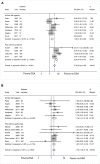Donor-specific antibodies adversely affect kidney allograft outcomes
- PMID: 23160511
- PMCID: PMC3507372
- DOI: 10.1681/ASN.2012070664
Donor-specific antibodies adversely affect kidney allograft outcomes
Abstract
The effect of low titers of donor-specific antibodies (DSAs) detected only by sensitive solid-phase assays (SPAs) on renal transplant outcomes is unclear. We report the results of a systematic review and meta-analysis of rejection rates and graft outcomes for renal transplant recipients with such preformed DSAs, defined by positive results on SPA but negative complement-dependent cytotoxicity and flow cytometry crossmatch results. Our search identified seven retrospective cohort studies comprising a total of 1119 patients, including 145 with isolated DSA-SPA. Together, these studies suggest that the presence of DSA-SPA, despite a negative flow cytometry crossmatch result, nearly doubles the risk for antibody-mediated rejection (relative risk [RR], 1.98; 95% confidence interval [CI], 1.36-2.89; P<0.001) and increases the risk for graft failure by 76% (RR, 1.76; 95% CI, 1.13-2.74; P=0.01). These results suggest that donor selection should consider the presence of antibodies in the recipient, identified by the SPA, even in the presence of a negative flow cytometry crossmatch result.
Figures




References
-
- Patel R, Terasaki PI: Significance of the positive crossmatch test in kidney transplantation. N Engl J Med 280: 735–739, 1969 - PubMed
-
- Karpinski M, Rush D, Jeffery J, Exner M, Regele H, Dancea S, Pochinco D, Birk P, Nickerson P: Flow cytometric crossmatching in primary renal transplant recipients with a negative anti-human globulin enhanced cytotoxicity crossmatch. J Am Soc Nephrol 12: 2807–2814, 2001 - PubMed
-
- Vaidya S, Partlow D, Susskind B, Noor M, Barnes T, Gugliuzza K: Prediction of crossmatch outcome of highly sensitized patients by single and/or multiple antigen bead luminex assay. Transplantation 82: 1524–1528, 2006 - PubMed
-
- Segev D, Wang G, Gloor J, Stegall M, Kapur S, Dunn T, Pelletier R, Singh P, Posner M, Shapiro RE-A: JM, Light, J, Marsh, C, Melancon, J, Lipkowitz, G, Wellen, J, Oberholzer, J, Montgomery, R: Risks of HLA incompatible kidney transplants by antibody strength: Initial results from a National study of 603 patients [Abstract]. American Transplant Congress, Philadelphia, PA, April 30–May 4, 2011
-
- Couzi L, Araujo C, Guidicelli G, Bachelet T, Moreau K, Morel D, Robert G, Wallerand H, Moreau JF, Taupin JL, Merville P: Interpretation of positive flow cytometric crossmatch in the era of the single-antigen bead assay. Transplantation 91: 527–535, 2011 - PubMed
Publication types
MeSH terms
LinkOut - more resources
Full Text Sources
Medical

